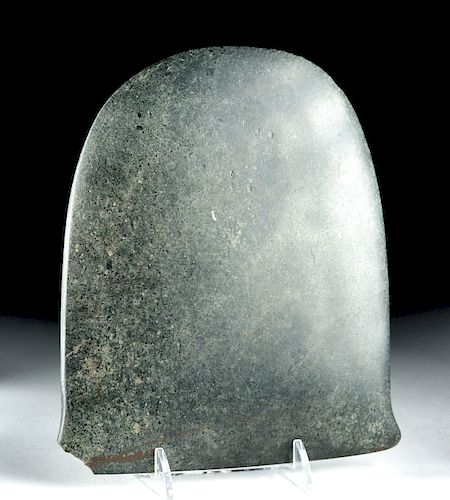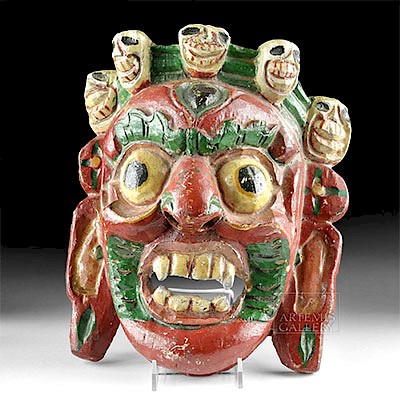Large Museum Exhibited Valdivian Greenstone Broad Axe
Lot 64
About Seller
Artemis Fine Arts
686 S Taylor Ave, Ste 106
Louisville, CO 80027
United States
Selling antiquities, ancient and ethnographic art online since 1993, Artemis Gallery specializes in Classical Antiquities (Egyptian, Greek, Roman, Near Eastern), Asian, Pre-Columbian, African / Tribal / Oceanographic art. Our extensive inventory includes pottery, stone, metal, wood, glass and textil...Read more
Estimate:
$500 - $700
Absentee vs Live bid
Two ways to bid:
- Leave a max absentee bid and the platform will bid on your behalf up to your maximum bid during the live auction.
- Bid live during the auction and your bids will be submitted real-time to the auctioneer.
Bid Increments
| Price | Bid Increment |
|---|---|
| $0 | $25 |
| $300 | $50 |
| $1,000 | $100 |
| $2,000 | $250 |
| $5,000 | $500 |
| $10,000 | $1,000 |
| $20,000 | $2,500 |
| $50,000 | $5,000 |
| $100,000 | $10,000 |
| $200,000 | $20,000 |
About Auction
By Artemis Fine Arts
Apr 25, 2019
Set Reminder
2019-04-25 10:00:00
2019-04-25 10:00:00
America/New_York
Bidsquare
Bidsquare : Pre-Columbian | Tribal | Ethnographic
https://www.bidsquare.com/auctions/artemis-gallery/pre-columbian-tribal-ethnographic-4035
Featuring ancient and ethnographic art from around the world, including Pre-Columbian, Native American, African / Tribal, Ethnographic, Spanish Colonial, Fossils, Fine Art, much more. Artemis Fine Arts info@artemisgallery.com
Featuring ancient and ethnographic art from around the world, including Pre-Columbian, Native American, African / Tribal, Ethnographic, Spanish Colonial, Fossils, Fine Art, much more. Artemis Fine Arts info@artemisgallery.com
- Lot Description
Pre-Columbian, Ecuador, Valdivian/Shillacoto-Wairajirca culture, ca. 1800 to 1500 BCE. A beautiful broad axe head of a substantial form with concave sides, a rounded blade edge, and a pair of miniscule handles projecting from the corners. The surface exhibits a meticulously smoothed texture formed over many hours using sandstone by master artisans. Hand axes of this form have been found as part of the Kotosh Religious tradition, a name that archaeologists have given to ritual buildings built between 3000 and 1500 BCE in the mountain drainages of the high Andes. Hand axes like this one, although shaped like a utilitarian tool, were made specifically for ritual purposes. Size: 6.5" W x 7.4" H (16.5 cm x 18.8 cm).
Exhibited in "Artifacts of Ecuador: Collection of Col. William R. Cameron (Ret.), Monterey Peninsula Museum of Art, January 8 to 29, 1977.
Provenance: private California, USA collection, acquired in 2004; ex-private Gill family collection, Pebble Beach, California, USA, acquired in 1980; ex-Colonel William R. Cameron (Ret.) collection, California, USA, acquired in 1965 to 1968; exhibited in "Artifacts of Ecuador: Collection of Col. William R. Cameron (Ret.), Monterey Peninsula Museum of Art, January 8 to 29, 1977
All items legal to buy/sell under U.S. Statute covering cultural patrimony Code 2600, CHAPTER 14, and are guaranteed to be as described or your money back.
A Certificate of Authenticity will accompany all winning bids.
We ship worldwide and handle all shipping in-house for your convenience.
#145147Loss to one handle. Light abrasions across both faces. Light earthen deposits throughout.Condition
- Shipping Info
-
All shipping is handled in-house for your convenience. Your invoice from Artemis Gallery will include shipping calculation instructions. If in doubt, please inquire BEFORE bidding for estimated shipping costs for individual items.
-
- Buyer's Premium



 EUR
EUR CAD
CAD AUD
AUD GBP
GBP MXN
MXN HKD
HKD CNY
CNY MYR
MYR SEK
SEK SGD
SGD CHF
CHF THB
THB













